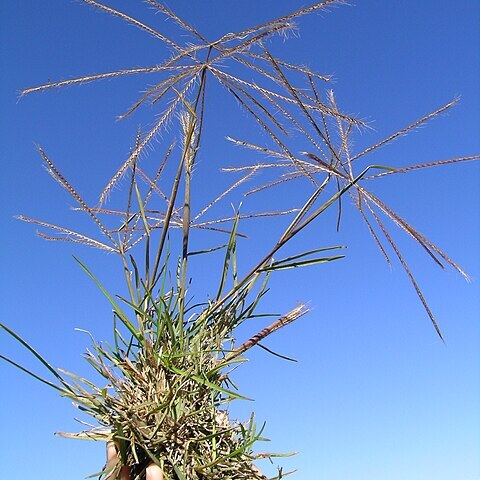Perennials, erect, with or without stolons. Flowering culms (10–) 16–45 (–50) cm high. Leaves: ligule 0.4–0.6 mm long; blade 3–14 cm long, 1.5–2.5 (–5) mm wide. Inflorescence branches 5–12, spreading or divaricate, (5–) 9–13 (–22) cm long. Spikelets subsessile or pedicellate, 2 (–3)-flowered, with 1 floret bisexual. Glumes smooth or scaberulous, with midnerve scabrous; upper glume 2.8–4.2 mm long. Callus pubescent to bearded. Basal lemma (1.8–) 2.4–4 (–4.5) mm long, minutely lobed, cartilaginous, not sulcate, smooth or scabrous, with pubescent hairs arising in the upper half of the submargins (hairs appressed or erect, less than 0.5 mm long); awn 1, 7–15 mm long. Caryopsis elliptic, 1.5–2.1 mm long, golden. Incomplete florets 1 or rarely 2, appressed to bisexual floret; lemma truncate, notched or obscurely 2-lobed, inflated, awned.
Tufted perennial 250-450 mm high; sometimes stoloniferous. Leaf blade 30-200 x 2-3 mm, apex broadly rounded and blunt; glabrous. Inflorescence digitate, racemes 6-15, 80-150 mm long, purplish-green turning black, flexuous, spreading horizontally; spikelets delicate, overlapping about half their length. Spikelet 2-3 mm long, 2-flowered; lower glume 1.5-1.8 mm long; upper glume 2.8ª4.0 mm long; lowest lemma 2.5-4.0 mm long, black when mature, sparsely to densely hairy only on the upper half of the margins to just below the apex, awn 6-15 mm long; second lemma 1.5 mm long, clavate, glabrous, awn 3.5-10.0 mm long; anther 0.3-0.5 mm long.
A grass that keeps growing from year to year. It has runners. It grows 45 cm tall. The leaves are 3-20 cm long by 2-3 mm wide. They are rounded at the top. The spikelets occur in a 1-sided arrangement. These are 8-15 cm long with 6-15 flowers.
Stoloniferous perennial to 45 cm. Leaves narrowly oblong, obtuse. Spikelets in 1-sided spike-like racemes, awns longer than lemma, 6-12 mm long.

